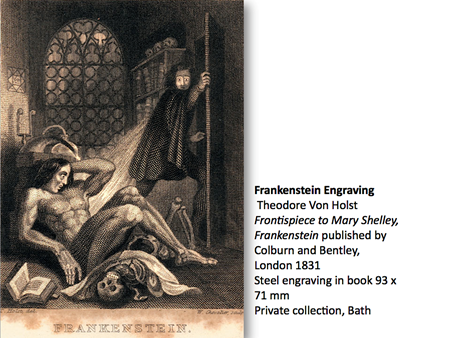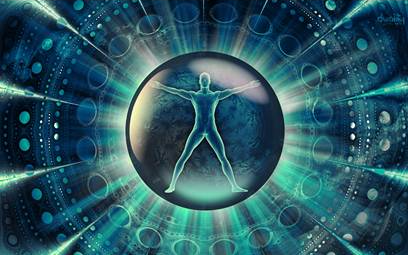Not Just Monkeys in the House: Applying Traditional Understandings of Identity to Alternative Attainment of Personhood Status
Kristi Scott
This article was adapted from a lecture given by Kristi Scott, IEET Program Director and PhD student at Southern Illinois University Carbondale, to the 6th Annual Colloquium on the Law of Futuristic Persons, December 10, 2010, at the Terasem Island Amphitheatre in Second Life.
As a Ph.D. student, Ms. Scott compares the traditional and more modern notions of identity and self spread across the increasing variety of roles, situations and cultures.
My name is Kristi Scott and I am a second-year PhD student at Southern Illinois University, Carbondale and a Program Director at the Institute for Ethics and Emerging Technologies. I have an interdisciplinary background including both mass communications and sociology with a wandering academic eye in areas of interest.
I am going to discuss the self and identity, particularly traditional notions and then some more modern ones, media effects, posthuman theory [1] and Frankenstein, along with considerations for future research.
I was first exposed to and turned on to the idea of 'mindware' by Dr. Rothblatt's [2] research about three years ago when I was on a panel with her during the Human Rights for the 21st Century Conference [3]. I had the privilege of hearing Dr. Rothblatt's presentation, I couldn't believe what I was hearing her say, it honestly blew my mind – it was complete science fiction. Of course, it makes sense that I thought it was science fiction.
Science fiction movies and literature contribute to our construction of science and cutting edge technologies. I was personally drawing on ideas that I had previously been exposed to, and using these fragments I constructed ideas about what I was hearing, how it would interact, and what it would do. Today, I hopefully draw on your collective identification markers and tags, with some references at the end to Frankenstein. Displayed in these images that are reflective of what I am talking about, are ones that I encourage you to explore and look at while you are reading.

It is interesting to note, given the topic of my article, that tagging and fragmentation, according to Marshall McLuhan, is not just what's exclusive to humans, but is also "the essence of machine technology [4]." A.L. Strauss compares the self to an egg and illustrates that no matter what you do to the egg, by cooking it, boiling it, frying it, etc., it remains true to its original state, which is merely to be an egg [5]. Strauss' point is that the self has an immutable integrity. Gergen [6] also asks this, but expresses the concept in a different way; "An individual who does not possess a sizable number of labels for himself has a truly difficult time in contemporary society." The self then, at the core, is the same, but is ever changing in its labeling and identification. To examine the self then, the researcher must examine the labels that particularly apply to the individual who is being examined. From Gergen [7] we can surmise that individuals carry multiple labels with them in society is nothing new. A fact that there is a possession of these multiple labels, functioning in society can be quite difficult. According to Stets and Burke [8], "The person identity is the set of meanings that are tied to and sustain the self as an individual; these self-meanings operate across various roles and situation.s"
"...there is an outside group influence that affects this perception of self by the individual."There are many roles we play in life, and with these roles we have these different labels and they contribute to this whole ideal of self. Again, A.L. Strauss (1959) points out that people may change as they appear, like the egg, or how they are, or how they act, but it is still the same stuff at the core; we're still an egg. We are merely opening up to something that was there the whole time. With the addition of socialization, there is an outside group influence that affects this perception of self by the individual [9].
According to William James [10], "A man's social 'me' is the recognition that he gets from his mates. We're not only gregarious animals, liking to be in sight of our fellows, but we have an innate propensity to get ourselves noticed." This adds to the idea that it's not just our own perceptions of who we are that makes up our perceptions of ourselves, it is also part of them, an influence by those around them. The social identity then draws from the group that they are surrounded by [11].

This perception of self is dependant on the closeness of the group around them, the connections with them and the interaction of their identity with the symbol or the social group that they are with [12]. Even though there might not be a physical presence that exists when a person is transferred from a physical-self to a digital-self, or any other, there can still be a strong sense of self that is created, maintained and restored which requires consideration. Some describe the blending of the self with a computer, or that the computers become then an extension of the self. The interaction on the screen becomes a very powerful presence in people's lives and puts this connection with the screen to be translated over to the other side of the screen and beyond [13]. Sherry Turkle [14] speaks about the way we are extended and blended in with our computers, with this becoming an extension of ourselves. The fact that we are putting a bit of ourselves into the computer makes it then a form of 'us' and who we are [15]. Potentially, we can argue that this 'us', through biostatic revival with the aid of computers and technology etc., is still a form of 'us'.
By incorporating the computer as a form of ourselves along the way in our formulation, we are adding yet another branch to the tree of the self that we create. With the computer, the Internet, online virtual communities such as this one, Second Life, biostatic revival, etc., we have then, psychologically created new ways of extending ourselves. These multiple extensions of self, as mentioned above, are able to coexist within that one person. Why not then with other forms of technology? The person at the core, like the egg, despite any change is the original person. In the virtual world, we wear the personality of our self through our avatar [16]. In the world of biostatic revival, we wear it as a revived body of ours, or another.
For a social identity to become incorporated with a sense of self permanently, according to Amy Gonzales [17], it need not take place in a real and physical sense. Instead, that identity can be one that is imagined or one the individual wants or expects to become part of his identity [18]. In the real world, changing of self and the way the groups we interact with accept us can be time consuming, expensive, and laborious. Not to mention that the groups we interact with have to be willing to accept this new self as we see it; we want them to accept into it. Our groups accept change in ourselves reluctantly since they already know us as they have seen us and interacted with them. They see our physical self and accept that as who we are [19].
"...a person’s self then is understandable, however a person is still a person despite the fact that they can modify the external self." Decisions such as undergoing cosmetic plastic surgery is one way to change ourselves, however, this is time consuming, expensive, and generally a painful experience [20]. When those changes occur to our bodies though, it changes the way we interact with each other. Despite the fact that the inside is essentially the same, it makes changes to let us both reflect in it and interact with it on the outside, and changes that interaction. A change in a person's self then is understandable, however a person is still a person despite the fact that they can modify the external self.
How do these notions then relate to media theory, posthuman theory and theoretical notions of Frankenstein's monster? Communication and the capability of communication are important for consideration of the person. The salience of ideas as proposed by Scheufele [21] is when ideas are seen by people through the media and then tagged for future reference. These tags then, are used to draw from and for future real comparable situations. With these identification markers, it is much easier for someone to draw upon the associated memory as opposed to it not being tagged and readily accessible.
The media then plays a role in the way we both construct our notions about daily life situations and also defines the limitations of exposure therefore resulting in a limitation of the discourse. In this way, the media plays into the way that culture is defined because it affects the discourse in the public sphere [22]. One way to engage in this discourse, for example a topic such as robots, is through examples taken from dystopic science fiction films. Films provide us a way for society to think more than they currently are about real technologies and the way they interact with society. It helps expose society to thoughts that they might not otherwise have had. By doing so, this helps with moving forward in pursuit of further thought, and the acceptance of thoughts previously not held [23]. When an audience is immersed in something such as a film, they may also be tied into the character on the screen, putting themselves in the screen, living the life, feeling the characters and what they feel, and tied together with what they see [24].
Barry Brummett [25] explored film as an 'equipment for living', where "As viewers apply their interpretation, they are necessarily looking to symbols located in the world outside of themselves to find relevance for their own experience." Meaning that they are able to take what they were so tightly wrapped up in as with a film and use that as a way to function in and as in information to apply to their lives as equipment for living.
It's important that we continue to look at the representation within the media and the way it relates to the world around it. Particularly because it contributes to both how we identify ourselves and others and how we contribute to the society and culture around us. Daniel T. Gillbert [26] recognized these changing perceptions and was cited by Holland [27] saying that, "People automatically accept what they perceive, get ready to act on it, and only on second thought, with a little extra effort, 'un-accept' it, according to [Daniel T.] Gillbert" [28]. What is being seen through things such as science fiction film are thoughts, ideas and fantasies that, in a sense, take effort to un-accept in the mind of the viewer. Much like the effort it takes to change when one changes their exterior body and then tries to interact with their friends. Their friends take effort to change how they perceive you.
Images and communications are areas of understanding of society and going back to Harold Lasswell [29] and Jürgen Habermas [30] as a way to engage in a more democratic society of understanding. Not only are our selves making an impression, but they can also make a change or a difference in people's perceptions about the technology or images they see.
Stephen Young [31] points out that "[T]he most pervasive type of influence films can have is when viewing leads to a change in viewers' thoughts, attitudes or beliefs. In these situations, films contribute to viewers' sense of who they are and can influence their general disposition to act in a particular manner in a given set of circumstances."
To understand this, I tied these notions of identity particularly to Frankenstein's monster and in using media theory, delve into posthuman theory. I draw from Judith Halberstam and Ira Livingston's [32] understanding, that "You're not human until you're posthuman. You were never human." Through this understanding we can see that while Donna Haraway's [33] understanding of posthumanity existed in the limited space between the human and non-human, it is also, as she acknowledges, a resulting space that has been around since the discovery of the use of tools.

The desire to use tools also translates to our human desire to enhance our bodies and our resources, much like with plastic surgery and changing the exterior of the self. According to N. Katherine Hayles [34], this means that "the posthuman view of things of the body as the original prostheses. We all learn to manipulate, so that extending or replacing the body with other prostheses becomes a continuation of a process that began before we were born." We are continually in a stage of reinventing and redefining ourselves, our identity, and extending our human. By taking this understanding of what it is to be a posthuman, we can apply to our understanding of areas involving man and technology. Through our merging with technology in the body, we become posthuman. Through our experiences of understanding our selves, we see ourselves in the media, as discussed before, as another form of technology. Through this media we see ourselves and understand how to interact with society, how to identify and how to interact with others around us; an example of this is through movies [35].
Elaine L. Graham [36] dedicates an entire chapter of her book, "Representations of the post/human: monsters, aliens and others in popular culture", just to Frankenstein and Frankenstein's monster. Connecting the monster to a posthuman understanding of what it is to occupy the liminal space between human and 'other'. According to Graham, "Frankenstein stands as one of the quintessential representations of the fears and hopes engendered by new technologies. Insofar as the creature at the heart of the tale is both (and neither). Alive or dead, born nor made, natural nor artificial, he confuses many of the boundaries by which normative humanity has been delineated."
Hereto tended and put together with great hopes of success, only to be let down, feeling violated; in the end, lashing out at others in which you and I would be truly able to join in society. Building off what William S. Haney II [37] says "corrupting the natural condition of the body, as in this case of Victor's monster, will inevitably distort the reflection of consciousness to the point that even the constructed self suffer."
Fast forward to earlier this year when I saw the New York Times reporter interviewing BINA48 [38], I didn't know what to think of what I was seeing. While this was not a person, it felt like a person. I wasn't there, however I have to acknowledge that my own willingness to consider her a 'being' and give her personhood left me wanting more. I went back to the books and have been researching like mad ever since, trying to better understand.
It's important to understand this form of identity and self and how it has been understood through history. Particularly when we're branching out into the realms of both digital and robotic representations and reinventions of the self. If it doesn't really translate in these forms back to the egg; is it really part of that? We can argue that it is, but what is it that people who are interacting with the media seeing; how do they then translate it? Are they referring to these movies; what does the media say?
The intersection of these three notions and the real technology that is seen through work such as BINA48 brings me to further areas of consideration and work that need to be addressed to fully understand what is going on both in science-fiction and how we understand and protect ourselves in what is being accomplished in the world today.
Endnotes:
____________________________________
[1] Posthuman - "(or transhumanism to use the standard term) is the view that we ought to try to develop - in ways that are safe and ethical - technological means that will enable the exploration of the posthuman realm of possible modes of being." http://www.posthumanism.com/ September 30, 2011 1:50PM EST
http://www.terasemcentral.org/about.html September 30, 2011 11:45AM EST
[3] Human Rights for the 21st Century Conference – "The 2007 conference "Human Rights for the 21st Century: Rights of the Person to Technological Self-Determination" will focus on (a) human rights in the context of bodily autonomy as well as reproductive and cognitive liberties, (b) emerging biotechnologies which may contribute to the exercise of such rights, and (c) challenges to the ideas of human identity underlying some rights discourse."
http://ieet.org/index.php/IEET/rights2007 September 30, 2011 11:52AM EST
[4] McLuhan, M. (1964). The medium is the message. Understanding media: The extensions of man, (pp. 23-35, 63-67). New York: Signet.
[5] Strauss, A. L. (1959). Mirrors and masks: The search for identity. Glencoe, IL: Free Press. Scott, Kristi. "The Second Self Through Second Life: Mask or Mirror?" Master's thesis, University of Southern Indiana, 2009.
[6] Gergen, K. J. (1971). The concept of self. New York: Holt, Rinehart & Winston (pg. 25).
[7] Gergen, K. J. (1991). The saturated self: Dilemmas of identity in contemporary life. New York: Basic.
[8] Stets, J. E. & Burke, P. J. (2000). Identity theory and social identity theory. Social Psychology Quarterly , 63(3), 224-237.
[9] Scott, Kristi, supra.
[10] James, W. (1968). The existential self and the person. In C. Gordon & K. Gergen (Ed.), The Self in Social Interaction (Vol. I, pp. 41-49). New York: Wiley.
[11] Scott, Kristi, supra.
[12] Brewer, M. B. (1996). Who is this "we"? Levels of collective identity and self representations. Journal of Personality and Social Psychology , 71(1), 83-93. Stets, J. E. & Burke, P. J., supra. Scott, Kristi, supra.
[13] Scott, Kristi, supra.
[14] Turkle, S. (1995). Life on the screen. New York: Simon & Schuster.
[15] Scott, Kristi, supra.
[16] Scott, Kristi, supra.
[17] Gonzales, A. L. (2008). Identity shift in computer-mediated environments. Media Psychology , 11(2), 167-185.
[18] Scott, Kristi, supra.
[19] Scott, Kristi, supra.
[20] McKenna, K. Y. (1998). Coming out in the age of the internet: Identity "demarginalization" through virtual group participation. Journal of Personality and Social Psychology , 75(3), 681-694. McKenna, K. Y. (2000). Plan 9 from cyberspace: The implications of the internet for personality and social psychology. Personality and Social Psychology Review , 4(1), 57-75. Scott, Kristi, supra.
[21] Scheufele, D. A. (2000). Agenda-setting, priming, and framing revisited: Another look at cognitive effects of political communication. Mass Communication & Society, 3(2&3), (pp. 297-316).
[22] Habermas, J. (1989). The public sphere: An encyclopedia article. In S. E. Bronner & D. M. Kellner (Eds.), Critical theory and society: A reader (pp. 136-142). (S. Lennox & F. Lennox, Trans.). New York & London: Routledge.
[23] Hodges, L. W. (2003). Cases and Commentaries. Journal of Mass Media Ethics, 18(3/4), 308-317.
[24] Young, S. D. (2000). Movies as Equipment for Living: A Developmental Analysis of the Importance of Film in Everyday Life. Critical Studies in Media Communication, 17(4), 447-468.
[25] Brummett, B. (1985). Electric literature as equipment for living: Haunted house films. Critical Studies in mass Communication, 2, 247-261, 454.
[26] Gillbert, D. T. (1991). How mental systems believe: reply. American Psychologist, 47(5), 670-671.
[27] Holland, N. N. (2008). Spider-Man? Sure! The neuroscience of suspending disbelief. Interdisciplinary Science Reviews, 33(4), 312-320.
[28] Holland (313) and Gillbert Id.
[29] Lasswell, H. (1948). The structure and function of communication in society. In L. Bryson (Ed.), The communication of ideas (pp. 37-51). New York & London: Harper.
[30] Habermas, supra.
[31] Young, supra.
[32] Halberstam & I. Livingston (Ed.. (1995). Posthuman bodies. (pp. 8, 73-96). Bloomington & Indianapolis, IN: Indiana University Press.
[33] Haraway, Donna (1989). Primate Visions: Gender, Race and Nature in the World of Modern Science. New York & London: Routledge.
[34] Hayles, N. Katherine (1999). How We Became Posthuman: Virtual Bodies in Cybernetics, Literature, and Informatics. (p. 3). Chicago, IL & London, UK: The University of Chicago Press.
[35] Halberstam & Livingston, Supra, Hayles, 1999 Id.
[36] Graham, E.L. (2002). Representations of the post/human. (pg. 62) New Brunswick, NJ: Rutgers University Press.
[37] Haney II, W. S. (2006). Cyberculture, cyborgs and science fiction: consciousness and the posthuman. (p. 91) Amsterdam: Rodopi.
[38] BINA48 – an intelligent computer, Binary Interface Neural Architecture 48 (48 exaflops per second processing speed and 480 exabytes of memory; exa = 10 to the 18th power), created by Hanson Robotics for Terasem Movement, in the image of Bina Rothblatt, Co-Founder of the Terasem organizations.
http://www.nytimes.com/2010/07/05/science/05robotside.html?pagewanted=all October 3, 2011 11:22AM EST
http://www.robotliving.com/robot-news/bina48-and-the-terasem-movement/ October 3, 2011 11:25AM EST
Bio

Kristi Scott, IEET Program Director: Rights of the Person, is a doctoral student in Mass Communication and Media Arts at Southern Illinois University, Carbondale. Her work centers on the way popular culture presents issues of identity, body modification, cosmetic surgery, robotics, science and emerging technologies.